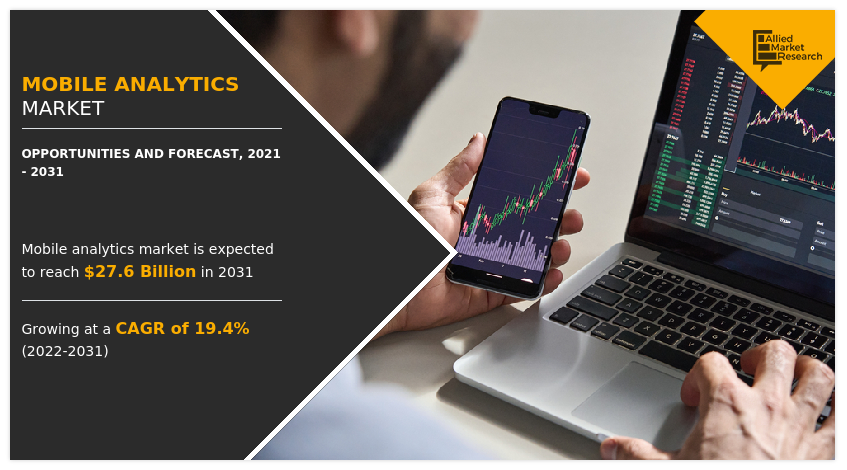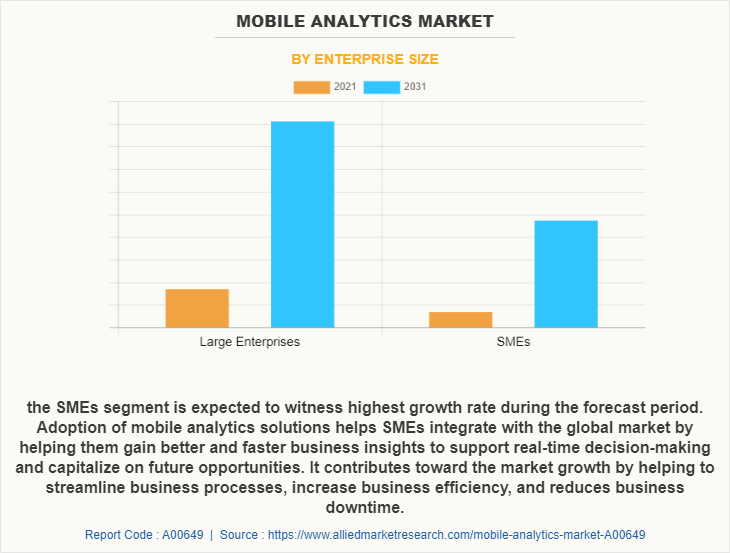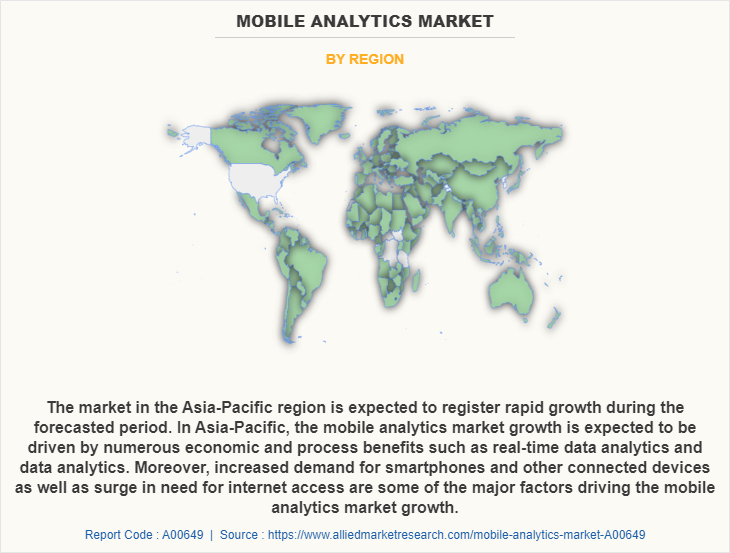Mobile Analytics Market Size & Share
The global mobile analytics market size was valued at USD 4.72 billion in 2021 and is projected to reach USD 27.60 billion by 2031, growing at a CAGR of 19.4% from 2022 to 2031.
The market penetration of smartphones and growth in demand to receive new and actionable insight on the buyers’ preferences have accelerated the need for mobile analytics worldwide. In addition, the upsurge in mobile advertising and advent of data analytics and big data have further boosted the mobile analytics market. However, lack of awareness on the benefits of mobile analytics and growth in privacy concerns have restricted the market growth for mobile analytics. On the other hand, with many enterprises entering the market and providing advance solutions would is expected to create greater opportunities during the forecasted period.

Analytics is the practice of measuring and analyzing data of users in order to create an understanding of user behavior as well as website or an application’s performance. Mobile analytics involves measuring and analyzing data generated by mobile platforms and properties, such as mobile sites and mobile applications. Mobile Analytics measures users' engagement with the app in addition to metrics related to the app itself, such as app installs, app launches, taps, screens, events, app versions, flows, user retention, funnel analytics, and more. Also, just like web analytics, mobile analytics tracks and measures similar metrics about users, such as how many new users are using the app, from which countries, which devices and versions.
Segment Review:
The mobile analytics market is segmented on the basis of offering, application, enterprise size, industry vertical, and region. On the basis of offering, the market is segmented into solution and services. On the basis of solutions, the market is segmented into mobile app analytics and mobile web analytics. Further, on the basis of mobile web analytics, the market is segmented into on-premise and cloud.
On the basis of application, the mobile analyticsmarket is segmented into mobile advertisement and marketing analytics, targeting and behavioral analytics, application performance analytics, others. On the basis of enterprise size, the market is bifurcated into large enterprises and SMEs.

Depending on industry vertical, it is segregated into BFSI, healthcare, retail & ecommerce, IT & telecom, travel & hospitality, media & entertainment, government and others. Region wise, it is analyzed across North America, Europe, Asia-Pacific, and LAMEA.
By organization size, the large enterprises segment dominated the growth in the mobile analytics industry in 2021, and is expected to maintain its dominance in the upcoming years. The increase in smartphone and internet penetration are the key drivers for the market growth. Moreover, the major factors driving the mobile analytics are increase in the mobile advertising and emergence of disruptive digital technologies like IoT and data analytics.
There is proliferation of mobile analytics in large enterprises across the industries such as retail, health care, and BFSI. However, the small and medium enterprises segment is expected to experience the highest growth rate during the forecast period.
North America dominates the mobile analytics market and is expected to continue its dominance trend over the forecast period, due to significant adoption rate of mobile analytics solutions due to cost effectiveness and scalability. Moreover, in North America, retail businesses are investing in their emerging technologies to streamline work processes. Adoption of mobile analytics improves retail sales and customer management performance.
Moreover, developed telecommunication infrastructure in the countries such as the U.S. and Canada boosts the use of cloud-based mobile analytics. Furthermore, retail firms are increasingly expected to use mobile analytics to boost their businesses and improve the customer experience, which is beneficial for growth of the market. In addition, businesses in North America are expanding their IoT business capability, which is anticipated to notably contribute toward the market growth.
However, Asia-Pacific is expected to witness highest growth rate during the forecast period. In Asia-Pacific, the market growth is expected to be driven by numerous economic and process benefits such as real-time data analytics and data analytics. Moreover, increased demand for smartphones and other connected devices as well as surge in need for internet access are some of the major factors driving the mobile analytics market growth. In addition, the growth of advertising and marketing through mobile platforms such as applications and web portals, is also driving the growth of the market in the region.

The report focuses on the growth prospects, restraints, and global mobile analytics market share. The study provides Porter’s five forces analysis of the global mobile analytics market forecast to understand the impact of various factors such as bargaining power of suppliers, competitive intensity of competitors, the threat of new entrants, threat of substitutes, and bargaining power of buyers on the global mobile analytics market trends.
Top Impacting Factors:
Factors such as growth in mobile users worldwide and increase in investment in mobile apps and increase in the demand for real-time analytics for personalized ads, impact the growth of the mobile analytics market globally. In addition, the market growth is affected by data security & privacy concerns and lack of technical manpower and lack of knowledge about benefits of mobile analytics solutions. Furthermore, increase in integrated mobile analytics solutions influences the market growth. However, each of these factors is anticipated to have a definite impact on the growth of the global mobile analytics market during the forecast period.
Growth in mobile users worldwide and increase in investment in mobile apps
The increase in number of smartphone users and the rise in preference for accessing online content from mobile devices has led many companies to focus on reaching customers through mobile applications. In addition, companies are developing mobile applications for businesses where they can improve the performance of applications by partnering with mobile analytics solution providers. Mobile analytics solutions provide various information such as mobile campaign optimization, user behavior, user preference, user location and more.
Increase in demand for real-time analytics for personalized ads
The continued growth in online purchases through mobile apps and increased emphasis on increasing customer retention have fueled demand for mobile analytics across multiple industries. In addition, the rise in reliance on mobile analytics among organizations to track mobile ad activity with real-time data and the need to deliver personalized ads that target individual customers based on their behavior and interests are expected to drive the growth of the global mobile analytics market during the forecast period. For instance, as per Oberlo, mobile advertising spend in the U.S.in 2022 is expected to reach $137.13 billion.
Regional Insights:
North America:
North America holds a significant share of the mobile analytics market due to its advanced mobile ecosystem, high smartphone penetration, and the presence of leading technology companies. The U.S. and Canada are at the forefront of adopting mobile analytics tools to enhance customer experiences, optimize mobile apps, and drive targeted marketing strategies. The region’s well-established e-commerce and mobile advertising industries, along with the widespread use of mobile apps for various services, drive demand for robust mobile analytics platforms.
Europe:
In Europe, the mobile analytics market is driven by the rapid digitalization of businesses and the increasing use of mobile applications across industries. The implementation of stringent data privacy regulations, such as the General Data Protection Regulation (GDPR), has pushed companies to adopt compliant and secure analytics solutions. Countries like the UK, Germany, and France are leading the adoption of mobile analytics as businesses seek to improve mobile app performance, customer engagement, and personalized marketing efforts.
Asia-Pacific:
The Asia-Pacific (APAC) region is experiencing the fastest growth in the mobile analytics market, primarily driven by the rapid expansion of mobile internet users and smartphone adoption. Countries like China, India, and Japan are key contributors to this growth, with a strong focus on mobile-first strategies across e-commerce, gaming, and social media. The increasing number of mobile app users in Southeast Asian countries also contributes to the rising demand for mobile analytics, as companies look to optimize user experiences and capitalize on the growing digital economy.
Latin America:
In Latin America, the mobile analytics market is expanding as more businesses adopt mobile-first approaches and e-commerce continues to grow. Countries like Brazil and Mexico are seeing increased smartphone penetration, driving the demand for mobile analytics to optimize mobile app performance and improve customer engagement. The region is focusing on leveraging analytics to enhance mobile marketing strategies and deliver personalized content to users, especially in industries such as retail, banking, and entertainment.
Middle East and Africa:
The Middle East and Africa (MEA) region is gradually adopting mobile analytics as mobile penetration increases and digital transformation initiatives take hold. Countries such as the UAE, Saudi Arabia, and South Africa are leading the adoption of mobile analytics tools to optimize customer engagement, mobile app performance, and marketing campaigns. The rise of mobile commerce and the growing importance of mobile applications in sectors like banking and retail are key drivers of market growth in the region.
Key Benefits for Stakeholders:
- This report provides a quantitative analysis of the market segments, current trends, estimations, and dynamics of the mobile analytics market analysis from 2021 to 2031 to identify the prevailing mobile analytics market opportunities.
- The market research is offered along with information related to key drivers, restraints, and opportunities.
- Porter's five forces analysis highlights the potency of buyers and suppliers to enable stakeholders make profit-oriented business decisions and strengthen their supplier-buyer network.
- In-depth analysis of the mobile analytics market segmentation assists to determine the prevailing market opportunities.
- Major countries in each region are mapped according to their revenue contribution to the global mobile analytics industry.
- Market player positioning facilitates benchmarking and provides a clear understanding of the present position of the market players.
- The report includes the analysis of the regional as well as global mobile analytics market trends, key players, market segments, application areas, and market growth strategies.
Mobile Analytics Market Report Highlights
| Aspects | Details |
| By Offering |
|
| By Application |
|
| By Industry Vertical |
|
| By Enterprise Size |
|
| By Region |
|
| Key Market Players | Micro Focus, Teradata Corporation, Splunk Inc., Webtrends, SAS Institute Inc., Microsoft Corporation, AT Internet, Mixpanel, SAP SE, Salesforce.com, Inc., Oracle Corporation, Microstrategy Incorporated, Adobe, Comscore, Inc., Google LLC, International Business Machines Corporation, TIBCO Software Inc. |
Analyst Review
In accordance with the insights by CXOs of leading companies, the global mobile analytics market is projected to witness prominent growth, especially in Asia-Pacific and North America. This growth is attributed to increased investments by organizations and governments for analytics tools and adoption of cloud-based mobile analytics solutions. In addition, the adoption of IoT (Internet of Things) based devices globally provides ample growth opportunities for mobile analytics solutions.
The current business scenario has witnessed an upsurge in the adoption of mobile analytics solutions in developed as well as developing regions as analytics solutions in retail maximizes business efficiency by minimizing operational efforts with faster processing times and lower labor costs, enhancing its adoption in the mobile analytics market.
Moreover, retail businesses are becoming more inclined to use mobile analytics technology to increase revenue, reduce costs, improve efficiency and provide customers with a better experience. Mobile analytics has transformed retail and e-commerce industries, by becoming a significant tool for marketing and advertising. Furthermore, mobile analytics has helped stores to make better decisions, collect and analyze data, automate workflows, and more. Analytics adoption has become even more vital due to change in lifestyles and ever-evolving corporate environments.
Moreover, enterprises make significant investments in R&D to enhance their existing solutions and deliver new solutions as well as develop new machine intelligence and automation technologies. For instance, in April 2019, CleverTap, raised $26 million in its new research hub for mobile analytics. This investment is expected to enhance the company’s efforts to enhance growth from emerging technologies by transforming business operations benefitting the mobile analytics market.
Prominent market players are exploring new technologies and platforms to meet the increase in customer demands. Product launches, partnerships, and acquisitions are expected to enable them to expand their product portfolios and penetrate different regions. For instance, in July 2021, Adobe introduced the Adobe Analytics curriculum for education, a global program that supports the future workforce with in-demand data science skills. As part of the next generation of the Adobe Education Exchange, college instructors and students will be able to use Adobe Analytics—the industry-leading customer data analytics platform—for free and get access to course curriculum with hands-on activities. Students are projected to learn how to use data to drive business decisions and gain skills for careers spanning data science to marketing and product management.
Asia-Pacific exhibits the highest adoption of mobile analytics solutions. On the other hand, LAMEA is expected to grow at a significant growth rate, anticipating a lucrative market growth for mobile analytics solutions.
The market penetration of smartphones and growth in demand to receive new and actionable insight on the buyers’ preferences have accelerated the need for mobile analytics worldwide. In addition, the upsurge in mobile advertising and advent of data analytics and big data have further boosted the mobile analytics market.
North America dominated the mobile analytics market North America dominates the mobile analytics market and is expected to continue its dominance trend over the forecast period, due to significant adoption rate of mobile analytics solutions due to cost effectiveness and scalability.
The global mobile analytics market was valued at $4,716.28 million in 2021, and is projected to reach $27,598.61 million by 2031, registering a CAGR of 19.4% from 2022 to 2031.
The mobile analytics market is dominated by key players such as Adobe, Google LLC, International Business Machines Corporation, Micro Focus, Microsoft Corporation, SAS Institute Inc., Oracle Corporation, SAP SE, Salesforce.com, Inc., TIBCO Software Inc., AT Internet, Comscore, Inc., Microstrategy Incorporated, Mixpanel, Splunk Inc., Teradata Corporation and Webtrends.
Loading Table Of Content...



